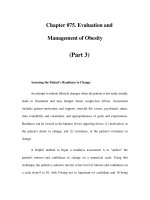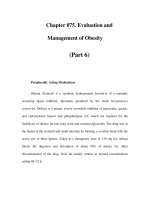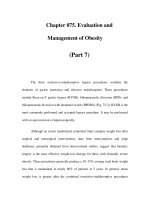Chapter 104. Acute and Chronic Myeloid Leukemia (Part 12) docx
Bạn đang xem bản rút gọn của tài liệu. Xem và tải ngay bản đầy đủ của tài liệu tại đây (49.98 KB, 5 trang )
Chapter 104. Acute and Chronic
Myeloid Leukemia
(Part 12)
Clinical Presentation
Symptoms
The clinical onset of the chronic phase is generally insidious. Accordingly,
some patients are diagnosed while still asymptomatic, during health-screening
tests; other patients present with fatigue, malaise, and weight loss or have
symptoms resulting from splenic enlargement, such as early satiety and left upper
quadrant pain or mass. Less common are features related to granulocyte or platelet
dysfunction, such as infections, thrombosis, or bleeding. Occasionally, patients
present with leukostatic manifestations due to severe leukocytosis or thrombosis
such as vasoocclusive disease, cerebrovascular accidents, myocardial infarction,
venous thrombosis, priapism, visual disturbances, and pulmonary insufficiency.
Patients with p230
BCR/ABL
-positive CML have a more indolent course.
Progression of CML is associated with worsening symptoms. Unexplained
fever, significant weight loss, increasing dose requirement of the drugs controlling
the disease, bone and joint pain, bleeding, thrombosis, and infections suggest
transformation into accelerated or blastic phases. Fewer than 10–15% of newly
diagnosed patients present with accelerated disease or with de novo blastic phase
CML.
Physical Findings
Minimal to moderate splenomegaly is the most common physical finding;
mild hepatomegaly is found occasionally. Persistent splenomegaly despite
continued therapy is a sign of disease acceleration. Lymphadenopathy and
myeloid sarcomas are unusual except late in the course of the disease; when they
are present, the prognosis is poor.
Hematologic Findings
Elevated white blood cell counts (WBCs), with increases in both immature
and mature granulocytes, are present at diagnosis. Usually <5% circulating blasts
and <10% blasts and promyelocytes are noted with the majority of cells being
myelocytes, metamyelocytes and band forms. Cycling of the counts may be
observed in patients followed without treatment. Platelet counts are almost always
elevated at diagnosis, and a mild degree of normocytic normochromic anemia is
present. Leukocyte alkaline phosphatase is low in CML cells. Serum levels of
vitamin B
12
and vitamin B
12
–binding proteins are elevated. Phagocytic functions
are usually normal at diagnosis and remain normal during the chronic phase.
Histamine production secondary to basophilia is increased in later stages, causing
pruritus, diarrhea, and flushing.
At diagnosis, bone marrow cellularity is increased, with an increased
myeloid to erythroid ratio. The marrow blast percentage is generally normal or
slightly elevated. Marrow or blood basophilia, eosinophilia, and monocytosis may
be present. While collagen fibrosis in the marrow is unusual at presentation,
significant degrees of reticulin stain–measured fibrosis are noted in about half of
the patients.
Disease acceleration is defined by the development of increasing degrees
of anemia unaccounted for by bleeding or therapy; cytogenetic clonal evolution; or
blood or marrow blasts between 10 and 20%, blood or marrow basophils ≥20%, or
platelet count <100,000/µL. Blast crisis is defined as acute leukemia, with blood
or marrow blasts ≥20%. Hyposegmented neutrophils may appear (Pelger-Huet
anomaly). Blast cells can be classified as myeloid, lymphoid, erythroid, or
undifferentiated, based on morphologic, cytochemical, and immunologic features.
Occurrence of de novo blast crisis or following imatinib therapy is rare.
Chromosomal Findings
The cytogenetic hallmark of CML, found in 90–95% of patients, is the
t(9;22)(q34;q11.2). Originally, this was recognized by the presence of a shortened
chromosome 22 (22q-), designated as the Philadelphia chromosome, that arises
from the reciprocal t(9;22). Some patients may have complex translocations
(designated as variant translocations) involving three, four, or five chromosomes
(usually including chromosomes 9 and 22). However, the molecular consequences
of these changes are similar to those resulting from the typical t(9;22). All patients
should have evidence of the translocation molecularly or by cytogenetics or FISH
to make a diagnosis of CML.
Prognostic Factors
The clinical outcome of patients with CML is variable. Before imatinib
mesylate, death was expected in 10% of patients within 2 years and in about 20%
yearly thereafter, and the median survival time was ~4 years. Therefore, several
prognostic models that identify different risk groups in CML were developed. The
most commonly used staging systems have been derived from multivariate
analyses of prognostic factors. The Sokal index identified percentage of circulating
blasts, spleen size, platelet count, age, and cytogenetic clonal evolution as the most
important prognostic indicators. This system was developed based on
chemotherapy-treated patients. The Hasford system was developed on interferon
(IFN) α–treated patients. It identified percentage of circulating blasts, spleen size,
platelet count, age, and percentage of eosinophils and basophils as the most
important prognostic indicators. This system differs from the Sokal index by
ignoring clonal evolution and incorporating percentage of eosinophils and
basophils. When applied to a data set of 272 patients treated with IFN-α, the
Hasford system was better than the Sokal score for predicting survival time; it
identified more low-risk patients but left only a small number of cases in the high-
risk group. Preliminary results suggest that both the Sokal and the Hasford
systems are applicable to imatinib-treated patients.









